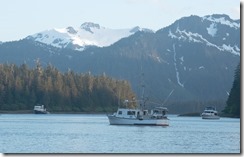After three nights in Petersburg and enjoying the Little Norway Festival, we depart early Monday morning, May 22. The wind and rain that occurred Saturday afternoon through Sunday night passed by and, while cloudy, the winds were light. We head for lovely Cannery Cove in Pybus Bay on Admiralty Island. We, of course, drop our prawn pots before anchoring for the night.
The forecast for May 23 is for increasing winds as the day goes on so we decide to spend another night in Pybus Bay but to move to an anchorage that might offer more protection against the expected winds. Moving also gave us the opportunity to harvest prawns from the pots we dropped the day before and to reset them with new bait. We head into Henry’s Arm which we hadn’t used since 2011.
 At first we are the only boat in the anchorage but by evening when the forecasted winds, NW 20 knots, show up there are 3 other boats with us. While it was breezy in the anchorage, we were protected from waves that are kicked up by the wind.
At first we are the only boat in the anchorage but by evening when the forecasted winds, NW 20 knots, show up there are 3 other boats with us. While it was breezy in the anchorage, we were protected from waves that are kicked up by the wind.
The next day conditions are good and we head out into Fredrick Sound heading for Gut Bay on Baranof Island. As we turn into Gut Bay, the winds suddenly are blowing a steady 15 to 20 knots from the west. Gut Bay, which is surrounded by steep cliffs and high mountains, apparently offers the wind a fairly direct path from the Great Arm of Whale Bay on the west side of Baranof Island to Chatham Strait on the east side of Baranof Island. Preferring to not have another windy anchorage we head to Thetis Bay, part of Tebenkof Bay on Kuiu Island.
While Thetis Bay was perfectly alright, we decide to try another anchorage in Tebenkof Bay (which is an impressively large bay). A few years early I had seen (via AIS) a boat use an anchorage and thought it’d might be pleasant. The anchorage is at the entrance of a very narrow channel which leads south to a nearly land locked cove (a cruising guide for SE Alaska gave this anchorage the name “Eye of the Needle”).
The next morning before departing, we decide to launch the dinghy in order to explore the channel and take measurements along the way. We hoist our dinghy, which weighs 400 pounds or so, with our boom. As we were pushing the stern of the hoisted dinghy over the side rail of the boat deck, the shackle holding the pulley through which the lifting line passes broke. The dinghy immediately falls, hits the rail, tilts stern first toward the water, plunges in, and flips upside down. In the process the lifting line had gotten jammed into a second pulley where it shredded and broke.
 At this point we are totally gobsmacked and standing on the boat deck looking down at our upside down dinghy drifting away in the wind and current. Marcia has the presence of mind to say “launch the kayaks.” After a short chase of the runaway dinghy we start pulling and pushing it back the 200-300 yards it had drifted. We secure the dinghy to the boat and have breakfast to let our nerves calm and come up with a plan.
At this point we are totally gobsmacked and standing on the boat deck looking down at our upside down dinghy drifting away in the wind and current. Marcia has the presence of mind to say “launch the kayaks.” After a short chase of the runaway dinghy we start pulling and pushing it back the 200-300 yards it had drifted. We secure the dinghy to the boat and have breakfast to let our nerves calm and come up with a plan.
We pull some spare hardware we had and reassemble a working a lifting arrangement. We first lift the dinghy up at the bow and flip it right-side up, next we pump out the water in the dinghy, then we attach to the dinghy lifting harness which was still intact and put the dinghy back on the boat deck.
In the end, while it would have been better if the shackle had not broken, we were fortunate it wasn’t worse. The dinghy has dent in the bottom and the 7 year old outboard engine is totaled (2 hours under water and 5 days with salt water stewing inside it before we got to port). Importantly neither of us were hurt and nothing was damaged on Alpenglow (the dinghy must have struck the rail at or near a vertical stanchion and shows no evidence of the impact).
 After we got the dinghy secured on the boat deck we headed south and across Chatham Strait and visited Little Port Walter, the site of a NOAA Research Center. The entrance is shallow so we left at sunrise the next morning to insure we had ample water under our keel. We headed north a reentered Gut Bay in calm conditions. We had a lovely evening enjoying the sunset on Mt Ada above our anchorage.
After we got the dinghy secured on the boat deck we headed south and across Chatham Strait and visited Little Port Walter, the site of a NOAA Research Center. The entrance is shallow so we left at sunrise the next morning to insure we had ample water under our keel. We headed north a reentered Gut Bay in calm conditions. We had a lovely evening enjoying the sunset on Mt Ada above our anchorage.
 From Gut Bay we continued north along Chatham Strait to Ell Cove, one of our favorite anchorages. We were the only boat there so we took our favorite location towards the NW corner of the cove. In the afternoon, we look out and see the troller Solstice pull in. We had been crossing paths with them for several weeks since we rounded Cape Caution. Dan and I congratulated each other on our good choices in anchorages.
From Gut Bay we continued north along Chatham Strait to Ell Cove, one of our favorite anchorages. We were the only boat there so we took our favorite location towards the NW corner of the cove. In the afternoon, we look out and see the troller Solstice pull in. We had been crossing paths with them for several weeks since we rounded Cape Caution. Dan and I congratulated each other on our good choices in anchorages.
We continued our journey to Sitka with a stop at Douglass Bay in Hoonah Sound (and more prawning), followed the next day with a night at the SE Cove of the Magoun Islands. We could have continued into Sitka but we enjoyed the quiet of one more night at anchor followed by a short 10 mile trip into Sitka and an early arrival in town.
Our plan is to stay in the Sitka area for about 3 weeks and then head north to Juneau followed by a trip into Glacier Bay starting July 4.


